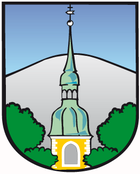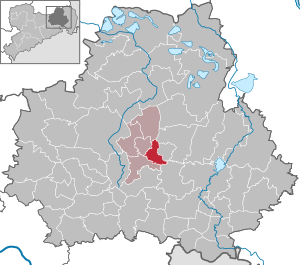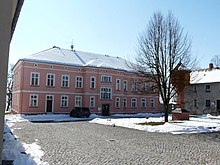Crostwitz
| coat of arms | Germany map | |
|---|---|---|

|
Coordinates: 51 ° 14 ' N , 14 ° 15' E |
|
| Basic data | ||
| State : | Saxony | |
| County : | Bautzen | |
| Administrative association: | At the monastery water | |
| Height : | 170 m above sea level NHN | |
| Area : | 13.33 km 2 | |
| Residents: | 1025 (Dec. 31, 2019) | |
| Population density : | 77 inhabitants per km 2 | |
| Postal code : | 01920 | |
| Area code : | 035796 | |
| License plate : | BZ, BIW, HY, KM | |
| Community key : | 14 6 25 080 | |
| LOCODE : | DE CSI | |
| Community structure: | 6 districts | |
| Address of the municipal administration: |
Am Hirtenquell 4 01920 Crostwitz |
|
| Website : | ||
| Mayor : | Marko Klimann ( CDU ) | |
| Location of the municipality of Crostwitz in the Bautzen district | ||
Crostwitz , in Upper Sorbian , is a place and the associated municipality in the center of the East Saxon district of Bautzen and is located approx. 12 km east of the city of Kamenz . The community belongs to Upper Lusatia and is a member of the administrative association Am Klosterwasser . Crostwitz is one of the centers of the Sorbian settlement area in Saxony.
As with Crostau , the place name is derived from the Old Slavic word chróst for “bushes” (cf. Upper Sorbian chrósćina = undergrowth, bushes).
geography
The place Crostwitz is between 160 and 180 m above sea level. NN on both sides of the Satkula stream , which flows into the monastery water a little north of the village . Together with Panschwitz-Kuckau, the community is part of the so-called "Oberland" (Sorb. Horjany ) of the former St. Marienstern monastery care . In the eastern part of the settlement, surrounded by the brook to the south and west, is the Kirchberg with the Catholic Church, the Crostwitz cemetery, the school and some older residential, partly half-timbered houses . However, the greater part of the village extends on the west side of the Satkula in the direction of Panschwitz-Kuckau. The next higher elevation is the Galgenberg at the northeast end of the village in the direction of Jeßnitz ( 216 m ).
Local division
The following districts belong to the municipality:
- Caseritz ( Kozarcy ), 43 residents
- Crostwitz, 571 inhabitants
- Horka ( Hórki ), 247 inhabitants
- Kopschin ( Kopšin ), 21 inhabitants
- Nucknitz ( Nuknica ), 56 inhabitants
- Prautitz ( Prawoćicy ), 100 inhabitants
history
In the vicinity of the Kopschin district are the remains of an old Slavic rampart, the so-called Kopschiner Schanze .
The place was mentioned in a document as early as 1225 as the manor of Henricus de Crostiz . The parish church of Crostwitz had been of great importance for the region between Panschwitz, Storcha and Rosenthal since the 13th century . Most of the other churches in the area were built later.
The plans for the Saxon Northeast Railway envisaged a route from Bautzen via Crostwitz towards Kamenz . With the outbreak of World War I and not least because of strong resistance from the population, construction was canceled and not resumed.
In the context of the National Socialist census of 1939, a total of 595 people in the whole of Lausitz declared themselves to be “Wendish ethnicity”, although this was expressly undesirable due to the propagated characterization of the Sorbs as “German tribe”. Of these so-called “confessional turns”, which, in contrast to the Sorbs who indicated German ethnicity, represented a political problem for the regime, 364 came from Crostwitz alone. Here, pastor Jan Wjenka had called in advance to declare oneself to be sorbent regardless of the nationality policy.
In April 1945, when the Second World War was already over elsewhere , heavy fighting took place in the region between Army Group South , some SS units, the 2nd Polish Army and the Red Army . A memorial erected on a hill commemorates the many victims. In Crostwitz on May 10, 1945 (only five days after the end of the last fighting) the umbrella organization of the Sorbian associations, the Domowina , was re-established.
In 1957 the neighboring Caseritz was incorporated , in 1974 Horka and Nucknitz .
population
Crostwitz is located in the southeast of the Sorbian core settlement area and is one of its centers. In 2001, 85.4% of the inhabitants of the municipality spoke Upper Sorbian . The majority of the population is also of Catholic faith.
For his statistics on the Sorbian population in Upper Lusatia, Arnošt Muka determined a population of 538 for the place in the 1880s, of which 523 were Sorbs (97%) and 15 were Germans. In 1956 Ernst Tschernik counted a Sorbian-speaking population of only 73.9% in the municipality of Crostwitz. a. due to the influx of resettlers from the former eastern areas.
According to the 2011 census, 984 of the 1,058 inhabitants were Roman Catholic (93%), 15 were Protestant (1.4%) and 59 belonged to another religious community or no religious community (5.6%). This makes Crostwitz the municipality in Saxony with the highest proportion of Catholics.
Culture and sights
Everywhere along the wayside crosses, prayer pillars and Sorbian lettering (on street signs, shops, schools, etc.) testify that Crostwitz is one of the centers of the lively Sorbian language and culture, here influenced by Catholicism .
The Sorbian rock music festival Nukstock takes place every summer in the Nucknitz district ; in Crostwitz itself there is also the International Folklore Festival Łužica / Lausitz every two years .
Crostwitz is on the bike path “In the footsteps of Krabat” .
church
Before the region was Christianized under Bishop Benno von Meissen , there was a pagan temple on the site of the current church. After the Catholic faith took hold, a small wooden church was built there in honor of the holy apostles Simon and Judah Thaddäus.
The parish church “St. Simon and Juda Thaddäus ” (Swj. Symana a Judy Tadeja) was built in its current form from 1769 to 1771 in the Baroque style and consecrated on October 27, 1771 by the Bishop Jakob Wosky von Bärenstamm from Crostwitz .
Every year it is the starting point for an Easter rider procession . After the riders have taken part in the Easter service together, they ride via Siebitz to the neighboring community of Panschwitz-Kuckau , where they are received by the nuns of the St. Marienstern monastery .
The Sorbian writer Jurij Brězan is buried in the Crostwitz churchyard .
Sports
The Crostwitz-based sports association SG Crostwitz 1981 ( Sportowa jednotka Chrósćicy ) emerged from the oldest Sorbian sports club, the Serbowka , founded in 1896, and is now the largest club in the municipality. From the 1930s on, Crostwitz had its own soccer team, Sokoł Chrósćicy . Today the men's team plays in the national class. Until 2014 there was also a women's team.
politics
The Crostwitz municipal council consists of twelve members and meets in the Sorbian language. The 2019 local elections resulted in the following distribution of votes and seats:
| Parties and constituencies | 2019 | 2014 | ||
|---|---|---|---|---|
| % | Seats | % | Seats | |
| Free Electoral Association Crostwitz / Prautitz (FWV) | 43.8 | 6th | 46.7 | 5 |
| Christian Democratic Union of Germany (CDU) | 43.4 | 5 | 53.3 | 7th |
| Crostwitz forward! | 12.9 | 1 | - | - |
| total | 100.0 | 12 | 100.0 | 12 |
| voter turnout | 71.7% | 60.6% | ||
A community merger with the neighboring community of Panschwitz-Kuckau , which was aimed for on July 1, 2011, failed due to differences of opinion among the community councils, including regarding the future conference language.
education

The municipality of Crostwitz has the Sorbian elementary school Jurij Chěžka with 73 pupils in the school year 2008/09.
Despite protests from Sorbian and church organizations, the neighboring countries of the Czech Republic and Poland and the Council of Europe , the ministry closed the Crostwitz Middle School at the end of the 2003 school year.
Personalities
- Jakob Wosky von Bärenstamm , cathedral dean and bishop in Bautzen
- Michael Kockel ( Michał Kokla , 1840–1922), landowner and member of the Saxon state parliament, lived in Crostwitz for decades.
- The Sorbian writer Jurij Koch was born in 1936 in the district of Horka.
literature
- Cornelius Gurlitt : Crostwitz. In: Descriptive representation of the older architectural and art monuments of the Kingdom of Saxony. 35. Issue: Amtshauptmannschaft Kamenz (Land) . CC Meinhold, Dresden 1912, p. 12.
supporting documents
- ↑ Population of the Free State of Saxony by municipalities on December 31, 2019 ( help on this ).
- ↑ Ernst Eichler , Hans Walther : Oberlausitz toponymy - studies on the toponymy of the districts of Bautzen, Bischofswerda, Görlitz, Hoyerswerda, Kamenz, Löbau, Niesky, Senftenberg, Weißwasser and Zittau. I name book . In: German-Slavic research on naming and settlement history . tape 28 . Akademie-Verlag, Berlin 1975, p. 150 .
- ↑ As of December 31, 2016; Information from am-klosterwasser.de
- ^ Frank Förster: The "Wendenfrage" in the German Ostforschung 1933-1945. Writings of the Sorbian Institute 43, Domowina-Verlag, Bautzen 2007, p. 103f.
- ↑ Martin Walde: Demographic-statistical considerations in the community association "Am Klosterwasser". In: Lětopis . Volume 51, 2004, Issue 1
- ↑ Ernst Tschernik: The development of the Sorbian population . Akademie-Verlag, Berlin 1954, p. 96 .
- ^ Ludwig Elle: Language policy in the Lausitz . Domowina-Verlag, Bautzen 1995, p. 251 .
- ↑ census database on zensus2011.de
- ^ Website of the community of Crostwitz
- ↑ Information from the headmaster
Web links
- Official community website
- Crostwitz in the Digital Historical Directory of Saxony










